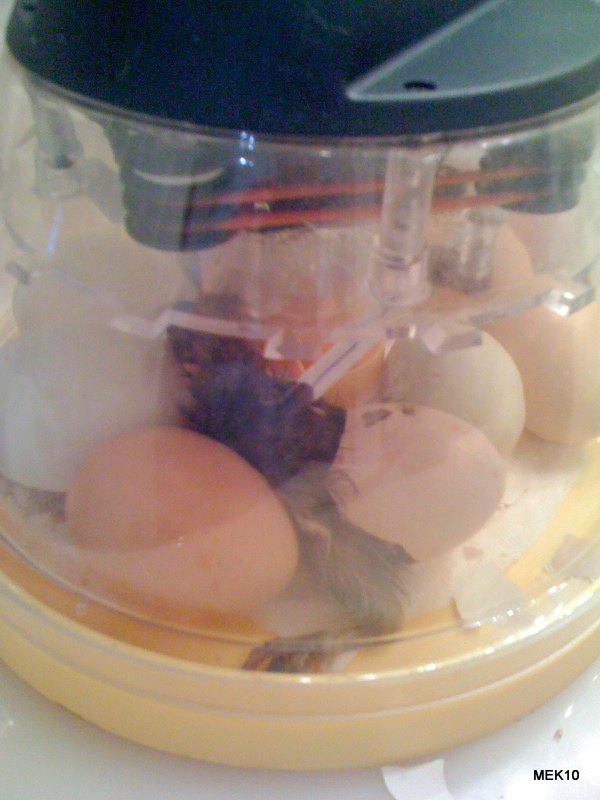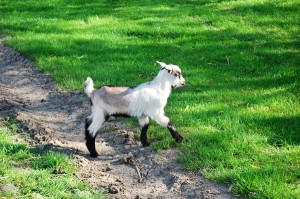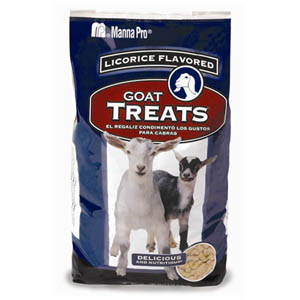How tall will they get?
Pygmies generally range from 16″ – 22″ at the withers. However, our African Pygmy’s (“Blackberry) mother was about 13”. Nigerian Dwarfs can range from “22 – 30”. The Nigerian dwarf (“Fairlight”) is estimated to be about 22″ at the shoulder.
Will they give milk?
Yes, they both can (although the Nigerian dwarf is a better milker), but unless you have a rare “maiden milker” you need to breed the goat in order to have milk.
How much room do they need?
From reading different sites and talking to breeders, they recommend a minimum of 30 square feet per goat. Our animal enclosure is over 400 square feet and it will be expanded to about 450 sq ft. They also will be allowed to roam the backyard under supervision, have access to a local park and neighbors’ yards. Being leash-trained, they can also go on walks and go hiking with the family.
Why do you have goats?
They are great companions (cleaner, quieter and more “useful” than dogs – they sleep all night!) and are a valuable addition to the homestead. Why? Well, we like to refer to them as natural composters and fertilizer machines. Sure beats an nondescript compost bin – these cute gals are fun and functional. Such animals have their function and place in such urban eco-system (or “urban permaculture” enviroment)
Do goats smell?
No. Females are very clean and smell like hay and sunshine. Goat droppings are dry (like little round pellets – similar to rabbits)and they are far easier to keep clean than many other farm animals. However, uncastrated male goats do smell.
Do they eat everything?
“Goats are very particular about what they eat. They will not consume food of poor quality or food that is dirty or has been trampled on. They require the best quality hay, green stuffs and concentrates (oats, barley, soya, linseed, etc., generally sold as a goat mix). However, goats will eat a wide range of food, preferring more fibrous food to lush grass. They will eat young thistles and brambles, as well as twigs. They also like bark from trees. Goats are inquisitive and will nibble and investigate most items (including the proverbial washing off the line!), but they are selective about what they actually eat.” { source:British Goat Society }
Are they legal?
As a matter of fact, yes. Goats are allowed in Pasadena. Of course, there are certain restrictions, one of them is that they must be 100 ft from neighbors. We are lucky that our 66′ x 132′ property is surrounded on two sides by a school.
Is this the first time you had goats?
No, we had goats in New Zealand (late 1970s’) and one milk goat in Florida on our 10 acre plot. Most of us kids grew up drinking raw goat’s milk.
{Side note} Dr. Freud would be proud. For the few weeks we have had these goats, we’ve made some pretty interesting observations watching the kids and adults interact. Guys gravitate to the pink nose (long-legged, graceful, poised), white goat, “Fairlight.” The girls, on the other hand, are drawn to the short and porky black goat — “Blackberry”.
Watching the people interact with these animals makes a fascinating study of the male/female makeup.
Nigerian Dwarfs
Nigerian Dwarf does can produce one to two quarts of milk per day on average. Their milk is extremely high in butterfat ~about 4-6% all the way up to 11%! If you take one gallon of a standard breed of goat milk (like the Saanen which has about 3.4% butterfat) you would be able to make three 8 oz containers of fromage cheese which is a soft cream cheese. Now take one gallon of Nigerian Dwarf milk and your yield will be seven 8 oz containers of fromage. That’s why butterfat is more important than quantity when it comes to cheesemaking! Does can be milked for 10 months or longer. Unlike most breeds, the Nigerian Dwarf can be bred year round, so you can have a year round milk supply if you so desire.
Courtesy of Joyful Hearts Farm
More…
They don’t require a lot of space for either housing or pen size. They are personable and easy to handle for the most part, although personally we’ve had to cull animals who were hard to catch. We’ve never had a Nigerian Dwarf show any inclination to bite or nail us to a wall. We find that bottle raising makes a difference. We’ve never had worry about catching a bottle baby! They are a hardy, naturally healthy breed, and of course their feed intake is significantly less than the larger breeds. For those of us who have seen huge vet bills with horses and other animals, it’s a real pleasure to keep the vet bills down. For their small size they produce a surprising quantity and quality of milk. Jay and I recently figured out that by milking three of our does, the return in milk and dairy products would reimburse us for the entire expense of hay and grain for our whole herd. Unlike their larger goat cousins, they’re easy to transport and ship by air or car in medium to large dog kennels, even as adults!
…Nigerians average 799 lbs of milk and 49 lbs of butterfat for a 305 day lactation. Butterfat percentage averages 6.1%. The minimum requirement for Nigerian Dwarf milk production is one third that of the standard sized breeds. It increases 2 pounds of milk for each additional month of age at time of freshening. The butterfat content is based on 5% of the minimum pounds of milk for the respective age.
Read article “Raising Nigerian Dwarf Goats”
African Pygmy
A general rule of thumb is that an average Pygmy doe should give about ½ gallon per day at the peak of her lactation. A gallon of average fat milk weighs 8.6#, but Pygmy milk weighs 8 lbs. because fat is lighter. Milk traditionally weighs 8.6 lbs per gallon. Pygmy goat milk only weighs 8 lbs per gallon, because it has a significantly higher butterfat content that the milk of most other breeds. (Nubians come the closest to the Pygmy’s fat content.)Why is high butterfat content a good quality in milk? For one thing, it helps the milk resist off flavors due to a doe’s diet. Strong flavored plants may impart their flavor to milk, especially when they are consumed within a few hours of milking. Higher fat content also extends the shelf life of milk. With very good milking technique and milk handling, Pygmy milk can retain its excellent flavor for about two weeks. Fat, of course, is what gives many foods a desirable taste because it is rich and sweet. When I dried off my does after two solid years of milking and bought 3.8% cow milk from the store, I had to spike it with whipping cream to combat the flat, watery taste! Many health-conscious people now avoid fat. But since Pygmy milk separates fairly readily, unlike the naturally homogenized nature of dairy goat milk, most of it can be skimmed off. A study comparing minerals in the milk of dairy goats and Pygmies (West African Dwarf Goats) in The Third International Conference on Goat Production and Disease, 1979, found that Pygmy milk tested 65% higher in calcium, 19% higher in phosphorus, 75% higher in potassium, 26% higher in iron, and 10% higher in copper. It was 21% lower in sodium, 13% lower in magnesium and 40% lower in chlorine. Alpine and Saanen results were averaged for the dairy milks. This study supports another one cited by Alice Hall. These percentages mean that Pygmy goat milk is higher in things that are good for you and lower in things that are not. Mention goat milk and many people grab their throats and gargle, “AAAGH!” Pygmy goat milk is extremely sweet and delicious. Does willingly give up to 2/3 gallon per day at the peak of their lactations. I feel a doe worth her keep should give half-a-gallon per day at her peak, but a quart a day is nothing to sniff at – that’s nearly two gallons a week! The butterfat content of Pygmy milk in our herd ranges from 4.5% to over 11%. High butterfat content means the milk resists off-flavors due to dietary causes and helps maintain milk’s sweet, delicious flavor longer in cold storage. Raw Pygmy goat milk has maintained its freshness and flavor in our refrigerator for 14 days. Pygmy milk is higher in calcium, phosphorus, potassium and iron than milk from dairy breeds, and is lower in sodium.Pygmy goats are more disease-resistant in some ways than other breeds. In Africa they are immune to the bite of the tse-tse fly – probably not a problem in your neighborhood. Demodectic mange affects Pygmies much less severely than dairy goats breeder causing bb-sized lumps in Pygmy skin but up to golf ball-size in dairy goats. Natural teat conformation helps Pygmy does resist mastitis, a bacterial infection of the mammary system, usually gaining entrance through the teat orifice. Pygmies usually have small orifices in addition to well-attached udders that are held close to the body, out of harm’s way.
Source: Kinne.net












I have a female Nubian and her half-brother who is neutered. As a vegetarian, I have hesitated breeding Gidget so I can milk her as I could not bear the idea of someone purchasing her off-spring and eating them nor do I have room to keep many more goats. How do you handle this situation? Thank you!